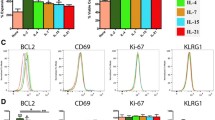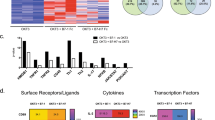Abstract
Background
It has been proposed that ligation of CD80 and CD86 induces reverse signaling into antigen-presenting cells. In this study, we tested the ability of abatacept, a soluble human fusion protein comprising the extracellular domain of cytotoxic T lymphocyte antigen 4 and a fragment of the Fc domain of IgG1, to activate antigen-presenting cells by measuring changes in global transcriptional responses.
Methods
Affymetrix chips were used to measure gene expression levels using mRNA isolated from immature and mature human dendritic cells and a B cell line following 6 h of treatment with abatacept.
Results
In contrast to robust transcriptional responses induced by the control treatment phorbol-12-myristate-13-acetate, abatacept induced minimal gene changes in three different populations of antigen-presenting cells. Furthermore, no gene changes were observed in response to belatacept, a modified version of abatacept that binds with higher avidity to CD80 and CD86.
Conclusions
We conclude that reverse signaling in antigen-presenting cells is unlikely to occur in response to either abatacept or belatacept, thereby supporting the modulation of CD28 signaling on T cells as the main mechanism of action for these therapeutics.





Similar content being viewed by others
References
Acuto O, Michel F. CD28-mediated co-stimulation: a quantitative support for TCR signaling. Nat Rev Immunol. 2003;3:939–51. doi:10.1038/nri1248.
Thompson CB, Lindsten T, Ledbetter JA, Kunkel SL, Young HA, Emerson SG, et al. CD28 activation pathway regulates the production of multiple T cell-derived lymphokines/cytokines. Proc Natl Acad Sci USA. 1989;86:1333–7. doi:10.1073/pnas.86.4.1333.
Linsley PS, Clark EA, Ledbetter JA. T-cell antigen CD28 mediates adhesion with B cells by interacting with activation antigen B7/BB-1. Proc Natl Acad Sci USA. 1990;87:5031–5. doi:10.1073/pnas.87.13.5031.
Lenschow DJ, Walunas TL, Bluestone JA. CD28/B7 system of T cell costimulation. Annu Rev Immunol. 1996;14:233–58. doi:10.1146/annurev.immunol.14.1.233.
Prabhu Das MR, Zamvil SS, Borriello F, Weiner HL, Sharpe AH, Kuchroo VK. Reciprocal expression of co-stimulatory molecules, B7-1 and B7-2, on murine T cells following activation. Eur J Immunol. 1995;25:207–11. doi:10.1002/eji.1830250134.
Azuma M, Ito D, Yagita H, Okumura K, Phillips JH, Lanier LL, et al. B70 antigen is a second ligand for CTLA-4 and CD28. Nature 1993;366:76–9. doi:10.1038/366076a0.
Hathcock KS, Laszlo G, Pucillo C, Linsley P, Hodes RJ. Comparative analysis of B7-1 and B7-2 costimulatory ligands: expression and function. J Exp Med. 1994;180:631–40. doi:10.1084/jem.180.2.631.
Lindsten TK, Lee P, Harris ES, Petryniak B, Craighead N, Reynolds PJ, et al. Characterization of CTLA-4 structure and expression on human T cells. J Immunol. 1993;151:3489–99.
Linsley PS, Greene JL, Brady W, Bajorath J, Ledbetter JA, Peach R. Human B7-1 (CD80) and B7-2 (CD86) bind with similar avidities but distinct kinetics to CD28 and CTLA-4 receptors. Immunity 1994;1:793–801. doi:10.1016/S1074-7613(94)80021-9.
Walunas TL, Lenschow DJ, Bakker CY, Linsley PS, Freeman GJ, Green JM, et al. CTLA-4 can function as a negative regulator of T cell activation. Immunity 1994;1:405–13. doi:10.1016/1074-7613(94)90071-X.
Davis PM, Abraham R, Xu L, Nadler SG, Suchard SJ. Abatacept binds to the Fc receptor CD64 but does not mediate complement-dependent cytotoxicity or antibody-dependent cellular cytotoxicity. J Rheum. 2007;34:2204–10.
Davis PM, Nadler SG, Stetsko DK, Suchard SJ. Abatacept modulates human dendritic cell-stimulated T-cell proliferation and effector function independent of IDO induction. Clin Immunol. 2008;126:38–47. doi:10.1016/j.clim.2007.08.019.
Linsley PS, Brady W, Urnes M, Grosmaire LS, Damle NK, Ledbetter JA. CTLA-4 is a second receptor for the B cell activation antigen B7. J Exp Med. 1991;174:561–9. doi:10.1084/jem.174.3.561.
Grohmann U, Orabona C, Fallarino F, Vacca C, Calcinaro F, Falorni A, et al. CTLA-4-Ig regulates tryptophan catabolism in vivo. Nat Immunol. 2002;3:1097–101. doi:10.1038/ni846.
Munn DH, Sharma MD, Mellor AL. Ligation of B7-1/B7-2 by human CD4+ T cells triggers indoleamine 2,3-dioxygenase activity in dendritic cells. J Immunol. 2004;172:4100–10.
Suvas S, Singh V, Sahdev S, Vohra H, Agrewala JN. Distinct role of CD80 and CD86 in the regulation of the activation of B cell and B cell lymphoma. J Biol Chem. 2002;277:7766–75. doi:10.1074/jbc.M105902200.
Larsen CP, Pearson TC, Adams AB, Tso P, Shirasugi N, Strobert E, et al. Rational development of LEA29Y (belatacept), a high-affinity variant of CTLA-4-Ig with potent immunosuppressive properties. Am J Transplant. 2005;5:443–53. doi:10.1111/j.1600-6143.2005.00749.x.
Irizarry RA, Hobbs B, Collin F, Beazer-Barclay YD, Antonellis KJ, Scherf U, et al. Exploration, normalization, and summaries of high density oligonucleotide array probe level data. Biostatistics 2003;4:249–64. doi:10.1093/biostatistics/4.2.249.
Knoerzer DB, Karr RW, Schwartz BD, Mengle-Gaw LJ. Collagen-induced arthritis in the BB rat. Prevention of disease by treatment with CTLA-4-Ig. J Clin Invest. 1995;96:987–93. doi:10.1172/JCI118146.
Webb LMC, Walmsley MJ, Feldmann M. Prevention and amelioration of collagen-induced arthritis by blockade of the CD28 co-stimulatory pathway: requirement for both B7-1 and B7-2. Eur J Immunol. 1996;26:2320–8. doi:10.1002/eji.1830261008.
Arima T, Rehman A, Hickey WF, Flye MW. Inhibition by CTLA4Ig of experimental allergic encephalomyelitis. J Immunol. 1996;156:4916–24.
Finck BK, Linsley PS, Wofsy D. Treatment of murine lupus with CTLA4Ig. Science 1994;265:1225–7. doi:10.1126/science.7520604.
Kremer JM, Dougados M, Emery P, Durez P, Sibilia J, Shergy W, et al. Treatment of rheumatoid arthritis with the selective costimulation modulator abatacept. Arthritis Rheum. 2005;52:2263–71. doi:10.1002/art.21201.
Genovese MC, Becker J, Schiff M, Luggen M, Sherrer Y, Kremer J, et al. Abatacept for rheumatoid arthritis refractory to tumor necrosis factor α inhibition. N Engl J Med. 2005;353:1114–23. doi:10.1056/NEJMoa050524.
Vincenti F, Larsen C, Durrbach A, Wekerle T, Nashan B, Blancho G, et al. Costimulation blockade with belatacept in renal transplantation. N Engl J Med. 2005;353:770–81. doi:10.1056/NEJMoa050085.
Boasso A, Herbeuval J, Hardy AW, Winkler C, Shearer GM. Regulation of indoleamine 2,3-dioxygenase and tryptophanyl-tRNA-synthetase by CTLA-4-Fc in human CD4+ T cells. Blood 2005;105:1574–81. doi:10.1182/blood-2004-06-2089.
Baban B, Hansen AM, Chandler PR, Manlapat A, Bingaman A, Kahler DJ, et al. A minor population of splenic dendritic cells expressing CD19 mediates IDO-dependent T cell suppression via type I IFN signaling following B7 ligation. Int Immunol. 2005;17:909–19. doi:10.1093/intimm/dxh271.
Boruchov AM, Heller G, Veri M, Bonvini E, Ravetch JV, Young JW. Activating and inhibitory IgG Fc receptors on human DCs mediate opposing functions. J Clin Invest. 2005;115:2914–23. doi:10.1172/JCI24772.
Veri M, Gorlatov S, Li H, Burke S, Johnson S, Stavenhagen J, et al. Monoclonal antibodies capable of discriminating the human inhibitory Fcγ-receptor IIB (CD32B) from the activating Fcγ-receptor IIA (CD32A): biochemical, biological and functional characterization. Immunology 2007;121:392–404. doi:10.1111/j.1365-2567.2007.02588.x.
Rankin CT, Veri M, Gorlatov S, Tuaillon N, Burke S, Huang L, et al. CD32B, the human inhibitory Fc-γ receptor IIB, as a target for monoclonal antibody therapy of B-cell lymphoma. Blood. 2006;108:2384–91. doi:10.1182/blood-2006-05-020602.
Viglietta V, Bourcier K, Buckle GJ, Healy B, Weiner HL, Hafler DA, et al. CTLA4Ig treatment in patients with multiple sclerosis: an open-label, phase I clinical trial. Neurology. 2008;71:917–24. doi:10.1212/01.wnl.0000325915.00112.61.
Author information
Authors and Affiliations
Corresponding author
Rights and permissions
About this article
Cite this article
Carman, J.A., Davis, P.M., Yang, WP. et al. Abatacept Does Not Induce Direct Gene Expression Changes in Antigen-Presenting Cells. J Clin Immunol 29, 479–489 (2009). https://doi.org/10.1007/s10875-009-9282-z
Received:
Accepted:
Published:
Issue Date:
DOI: https://doi.org/10.1007/s10875-009-9282-z




